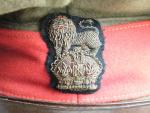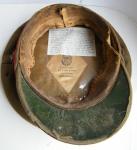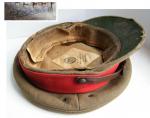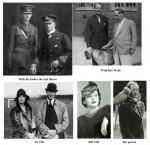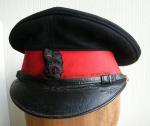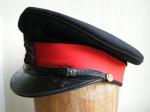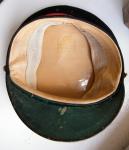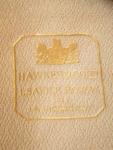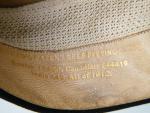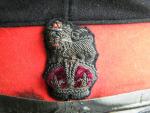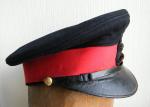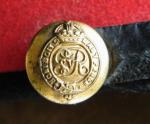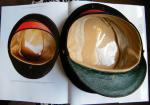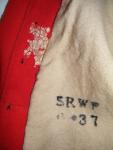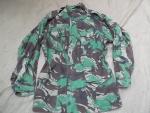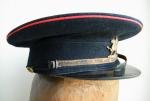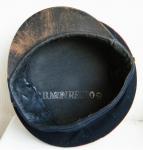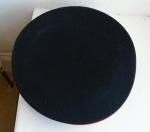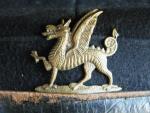-
Posts
527 -
Joined
-
Last visited
Content Type
Profiles
Forums
Blogs
Gallery
Events
Store
Everything posted by Jerry B
-
Some extracts from the links. The Tredegar house link Evan always looked ill. He had asthma and other complaints. In February 1916 he had pleurisy, a few months later he was operated on for an abscess in his ear and the following summer had damaged the cartilage in his knee. Evan began to receive a series of odd postings and attachments. These included being a King’s messenger (Carrying diplomatic papers to Embassies), finding himself on the staff of disgraced French General Robert Nivelle in North Africa and then back to convalesce in Oxford after some malady. This would be the chance for another opportunity to get an invite to Garsington Manor and a chance to rub shoulders with the in-crowd. It was probably on one such trip that he met with Robert Graves who had been hospitalised after being wounded in France. They had been canoeing together and the meeting would prove to be a very useful one to Graves some months later. Robert Graves and fellow poet Siegfied Sassoon were both serving officers in the Royal Welch Fusiliers. Sassoon had been decorated for bravery, but was becoming increasingly disillusioned. He too was a visitor to Garsington and it may well have been on the trips that he was persuaded to write an open letter which was widely distributed and appeared in the press, condemning the war and announcing his refusal to take further part in it. Graves knew this would mean Court Martial and at least prison which he doubted Sassoon would survive. Therefore he got in touch with Evan to see if he could use his Cabinet contacts for Sassoon to be deemed medically unfit instead. Evan succeeded. The daily mail link He was one of the richest peers of the realm, a multi-millionaire with such a stash of inherited wealth he never needed to think about working. But Evan, Viscount Tredegar, was more than your average spoilt aristocrat — he was one of the most riotously outrageous and toxic eccentrics ever to emerge from the English upper classes. He studied for the priesthood, but practised black magic and befriended sinister occultist Aleister Crowley. Even though he married an English actress and a Russian princess, he was a promiscuous homosexual. He wrote poetry and dressed like Shelley, yet he was so juvenile that he trained his parrot Blue Boy to climb the inside of his trouser-leg and pop its head out of his flies. The bizarre viscount even ran a homing-pigeon scheme for military intelligence during World War II, but was court-martialled for revealing its secrets to two Girl Guides. And all around him, as he made his wayward path through life, friends had the mysterious habit of dying. ‘His friendship was a kind of curse,’ says William Cross, author of a new biography of the Welsh peer. Evan Tredegar became a figure of horrified fascination to High Society Britain in the Twenties and Thirties as he pursued his twin lusts — higher learning and sex. More... Smile that says he's on the mend: Prince Philip strides out... in his surgical stockings Beaming Queen flanked by Charles and William at Order of the Garter today as Duke of Edinburgh recovers at home 'Thieves, murderers, oppressors and infidels!' Why Nelson really did hate the French What else would you expect from a man whose mother believed herself to be a kingfisher and built bird’s nests big enough to sit in? The dystopian world that Evan Frederic Morgan, 2nd Viscount Tredegar, built for himself was only made possible by colossal wealth. When he came of age, the vast Welsh estate his family had owned since the 14th century was bringing in the equivalent of £65,000 a day — or £24 million a year. Early life: Evan Morgan pictured with his father, the then Viscount Tredegar, when he was a 2nd Lieutenant in the Welsh Guards Home was Tredegar House, a ghostly, depressingly ugly pile near Newport in South Wales. Evan’s father had made himself useful during the First World War by handing over his private yacht to the Royal Navy — on condition that he was appointed its captain. Money rather than service bought the gold braid with which he festooned himself — so while he was still a schoolboy, Evan learned that a title, and colossal wealth, could get you anything you wanted. At Eton, he forged the friendships that were to shape his screwball life. His best friend Peter Churchill, a cousin of Winston, spent part of his childhood in North Africa and claimed to have sold sexual favours to men in return for pocket-money. W hile still at Eton the pair became pageboys to the royal court at Windsor at a time when, author Cross claims, ‘mothers of vulnerable sons were known to insist their cherished boys steer well clear of the well-known paedophiles at court’. But it was too late — both boys had already acquired a preference for their own sex, and before long Evan was kicked out of Eton under the inevitable cloud. It further counted against him that while at school he had created a circle of black-magic enthusiasts. Inspired by Peter Churchill’s tales from North Africa of temples, casbahs, souks and arcades where magicians and tricksters plied their trade, the boys dabbled in rites and rituals which were to become a central part of Evan’s life. With no need to work, Evan settled on becoming a poet. The first timer: Despite never hiding his homosexuality and having a constant string of illicit affairs, Viscount Tredegar married Viscountess Lois Sturt in 1928 Moving in the arty circle centred on the bohemian Cafe Royal in London, he became friends with the painter Augustus John and the writer Ronald Firbank, a dandy with red-lacquered fingernails. During this period Evan developed a taste for partying and buying sex from working-class rent boys. The viscount was no looker — Virginia Woolf described him as ‘a little red absurdity with a beak of a nose, no chin, and with the general likeness of a callow but student bantam cock that has run to seed’. And in the helter-skelter world of Britain after World War I, filled with flappers and cocktails and drug addicts, Evan was constantly in search of newer, darker, sensations. He was fatally attracted to dangerous people. The occultist Aleister Crowley was known to society as ‘the wickedest man in the world’ and in the Twenties people were genuinely terrified by the mention of his name — a byword for all that was mad, bad and dangerous to know. Born the son of a brewer in Leamington Spa, Crowley, who called himself ‘The Great Beast 666’, had built up a terrifying reputation as a disciple of the Devil. His stated purpose was to destroy the country’s religious and spiritual equilibrium. Number two: Princess Olga Sergievna Dolgorouky became Viscout Evan Tredegar's second wife Little wonder then that the vicious Viscount, with his schoolboy dabblings in the occult, should hasten to Crowley’s side — the pair met for the first time in Paris. Later Crowley went to stay at Tredegar House where Evan proudly revealed his Black Magick room — ‘far greater than I thought!’ marvelled Crowley. Despite his ostentatiously weird life — in his garden he kept a boxing kangaroo, a honey bear and a baboon, while in his bed he kept rabbits — Evan Morgan was still considered by ambitious mothers to be one of the country’s most eligible bachelors. Only when girls got close to him did they realise how completely impossible life at Tredegar House would be. However, Lois Sturt, daughter of the land-rich Lord Alington, was not so choosy. She had some of the same madness that infected Evan Tredegar and a whole swathe of the post-war Bright Young People. Needy, nervy, self-centred and eccentric, she was also pretty, sexy and willing to overlook Evan’s homosexuality.They married when she was 28 and he 35. But it was doomed from the start. Lois had already developed an addiction to drugs which would kill her before long. When they married in Knightsbridge, the crowds had to be held back by police, but the high-society union between Lois and Evan was not what it seemed. Each agreed the other could sleep with whom they pleased as long as it didn’t interfere with their life together. But Evan’s relentless all-male promiscuity and his love of rent boys soon rattled Lois, and before long they parted. Later he married the shapely Princess Olga Sergievna Dolgorouky, a refugee scarred by her escape from the Russian Revolution, but otherwise an innocent abroad. The marriage was annulled, unsurprisingly, on the grounds of his non-consummation after three years. Evan showed far greater devotion to his menagerie at Tredegar than he did to either of his wives. Easy life: Lord Tredegar, pictured at Tredegar Park near Newport with writer H G Wells, could live comfortably off his estate which brought in £24million per year Birds were a big part of his life. His Australian parrot, though described by Evan as ‘witless and uncontrollable’, was nothing of the sort. After teaching it the trick of crawling up the inside of his trouser leg and poking its head out of his flies, the Viscount promptly walked into the Cafe Royal and performed the routine in front of a packed house. One of the onlookers recorded that ‘the effect on old ladies present can be imagined’. Periodically, Evan would decide that he must do something serious with his life. When war was declared in 1939, he managed to get himself taken on by MI14, the secret service department detailed to handle carrier pigeons bringing back messages from frontline troops in France. So unused was he to the discipline which goes with military work, that he let two Girl Guides look at the map used to plan the 1942 Allied attack on Dieppe — which, coincidentally, turned out to be one of the war’s greatest military disasters. Such was the horror of superior officers when they learned that he had divulged highly secret troop deployment details — even though it was only to a couple of teenage girls — that Tredegar was court-martialled. Story of a life: Evan Morgan, 2nd Viscount Tredegar, died in April 1949, aged 55, survived by his beloved parrot He was found guilty and banished to an honorary post in the Welsh Home Guard, but even that small responsibility proved too much for him. Hopeless in war, the Viscount remained equally rudderless in peace. Throughout his life the ostensibly high-minded Evan described himself as a poet, modelling himself on Shelley and even dressing as the Romantic poet, but he failed to attract the praise of any but the most sycophantic critics. Rich though he was, Evan could not buy literary success — and rich though he remained, he could no longer buy friendship in the way he once had. Indeed, his friendship was something of a curse. Those who were close to Evan seemed to die in their droves — often tragically young. First was Guy Colebrooke, a fellow royal pageboy, who died aged 27. Then Ronald Firbank died of lung cancer at the age of 40. He was followed by fellow-drinker Sir Guy ‘Fatty’ Laking, who succumbed to alcohol poisoning at 26. One of Evans’s lovers, the Earl of Lathom, keeled over from tuberculosis brought on by a dissipated life, while another lover, the Hon James Rodney, was killed in a house fire. Friends Peter Watson, a wealthy art patron, and Sir Johnnie Philipps both drowned in their baths. And another friend, the artist Nina Hamnett, plunged out of a window, impaling herself on the railings 40ft beneath. There were suicides, too: the artist Kit Wood, the composer Peter Warlock, fellow Etonian Brian Howard and writer Richard Rumbold. Even his first wife’s brother, the Hon Gerard Sturt, killed himself. His sister Gwyneth succumbed to drug abuse and her body was found washed up on the Thames shore in 1924. And so the party — that gay, abandoned, reckless party of parrots, poetry and promiscuity — eventually ended. Evan Morgan, whose riches so completely detached him from life, finally parted company with it on April 27, 1949 — a victim to cancer at the early age of 55. The trouser-climbing parrot survived him. Not Behind Lace Curtains — The Hidden World Of Evan, Viscount Tredegar, by William Cross (Book Midden Publishing, £12), is available on Amazon. Read more: http://www.dailymail.co.uk/news/article-2343546/The-devil-worshipping-viscount-VERY-naughty-party-trick-parrot.html#ixzz3BmzgAL00 Follow us: @MailOnline on Twitter | DailyMail on Facebook
-
An interesting cap that has an appeal to me on for a number of reasons which is why I was pleased to buy it recently. It dates to the Great War period and is a Staff officers service dress cap, nice in its own right just because of this, though condition is somewhat surrefering because of its age, but still good to my eyes. Secondly it is named and the owner -the honourable Evan Frederick Morgan- was known to have served with the Welsh Guards from early in their formation in 1915 until his transfer to tbecome a staff officer, being personal private secretary to WC Bridgeman MP who was parlimentary secretary to the minister for labour. In this position he was able after being asked by his friend Robert Graves -the famous war poet and officer with the Royal Welsh Fusiliers- to help the Siegfried Sassoon -another famours war poet and officer with the RWF- avoid being court martialled for his anti war letter following his wounding on the Western Front. The original owner of the cap -it is named to him and also has a written short history of him stuck inside the celulose head liner- was the son of the 3rd Baron Tredegar who also served during the great war. After his death Evan F Morgan became the 4th Baron Tredegar -2nd Viscount- and they owned the stately home Tredegar House near Newport in South Wales. The 4th Baron was known for being a very colourful character-he was somewhat of an eccentric- and associated with Alistair Crowley the well known satanist and also the author H.G.Wells. The Baron was wellknown for keeping a boxing kangeroo as a pet and also kept a parrot with which he performed an infamour party trick and he was the subject of a book on his life -see links below. He married twice and his 2nd wife was a Russian princess. During WWII he worked in inteligence and was involved in work relating to the use of homing pidgeons and was also involved in the planning of the Diepe raid, the latter which got him into trouble as he confided in two teenage girls some of the details for the planning of the raid and for which he was sacked form his position. Local history article http://tredegarhouse.wordpress.com/ Daily Mail article about the book on him http://www.dailymail.co.uk/news/article-2343546/The-devil-worshipping-viscount-VERY-naughty-party-trick-parrot.html A painting of him http://www.nationaltrustcollections.org.uk/object/1553476 Another painting of him http://www.nationaltrustcollections.org.uk/object/1552383 Wikipedia link for him http://en.wikipedia.org/wiki/Evan_Morgan%2C_2nd_Viscount_Tredegar
-
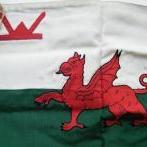
Staff officers cap circa pre WWI
Jerry B replied to Jerry B's topic in Great Britain: Militaria: Badges, Uniforms & Equipment
I have another staff officers cap from WWI on its way to me, it should have arrived today and he was ex Welsh Guards but it appears from the sellers pics to have a very flat peak. In the hand will tell and I'll start a thread on it when it arrives as the owner had a very colourful life in war and peace. -

Staff officers cap circa pre WWI
Jerry B replied to Jerry B's topic in Great Britain: Militaria: Badges, Uniforms & Equipment
Thanks Mervyn. I am not sure what you mean by the peak being high? The guards units tend to have a very vertical peak from what I have observed, whilst this falls within the "normal" range of peak angles, some are nearly horizontal, whilst others are more drooping with those for the guards being as close to vertical as it is possible to get it. A Welsh Guards example from 1958 at top left, note the angle of the peak when compared with other caps. Also note another staff officers cap at bottom left has a similar angle to the thread starter as do all those in the bottom row. (6 out of the 9 caps shown belong to me, the other images are from my reference collection.) -

Staff officers cap circa pre WWI
Jerry B replied to Jerry B's topic in Great Britain: Militaria: Badges, Uniforms & Equipment
Thanks Bob, by a strange coincidence I saw another example for sale recently, probably post WWI from the look of it, but the same as this, a staff officers forage/dress cap. -
A new addition to my collection, which has featured in a recent book on British officer caps. It is probably dated to just prior to the great war or perhaps from the early post war period. It is made by Hawkes & Co with their new address (at the time) of #1 Saville Rd, late of 14 Picadilly and a pattern apllied date of 1912. It is a staff officers forage cap, rather than a Brigadier or Colonels so does not have the braid on the peak. the khaki version without braid is more commonly seen but these can also be found sometimes, another one sold recently on the bay. It has buttons for George V so that confirms it dates to between 1912, from the pattern date and 1936 when George V died, though as I mentioned above I tend to think a date of circa 1912-1914 is most likely. I have included two pictures of it alongside the book in which it appears.
-
Excellent work, great to see sassoon in particular, as I am a collector and historian to the RWF.
-

Argyll & Sutherland Highlanders
Jerry B replied to MichaW's topic in Great Britain: Militaria: Badges, Uniforms & Equipment
Better detail pictures would allow informed comments to be made concerning its date etc. Interior images of both Bonnet and tunic might help, traces of any labels or inkstamps for instance. If pre 1914 the tunic should have a paper label or signs where it once was, similar to this from a RWF example in my collection. -

ww1 uniform
Jerry B replied to blueman's topic in Great Britain: Militaria: Badges, Uniforms & Equipment
Sadly no doubt about it at all. -

ww1 uniform
Jerry B replied to blueman's topic in Great Britain: Militaria: Badges, Uniforms & Equipment
The fabric label was not introduced until some time in the 1920's and in this case post 1922, probably dated 1940's (1945?) and someone has modified it to try and read 1915. The seller or some previous owner needs a slap if you ask me for trying to fake this. -

ww1 uniform
Jerry B replied to blueman's topic in Great Britain: Militaria: Badges, Uniforms & Equipment
And the stripes look to be the wrong pattern for WWI. -

ww1 uniform
Jerry B replied to blueman's topic in Great Britain: Militaria: Badges, Uniforms & Equipment
Indeed, it also only has one pleat below the collar as well as looking brand new. As far as the latter goes, they can look good for their age, but not brand new from this date I think. -

ww1 uniform
Jerry B replied to blueman's topic in Great Britain: Militaria: Badges, Uniforms & Equipment
From these pics it is either the post 1922 version or a copy and It would help to see the interior. -

Great Britain Collar Insignia
Jerry B replied to UK_IN_US's topic in Great Britain: Militaria: Badges, Uniforms & Equipment
It might be one of the fusiler regiments perhaps, though nothing else that looks like a spade springs to mind. -

Great Britain Collar Insignia
Jerry B replied to UK_IN_US's topic in Great Britain: Militaria: Badges, Uniforms & Equipment
-

Help with a british army jacket
Jerry B replied to Gungadd's topic in Great Britain: Militaria: Badges, Uniforms & Equipment
this one is said to be 68 pattern dpm http://www.ebay.co.uk/itm/ORIGINAL-1968-70-DPM-68-COMBAT-JACKET-SMOCK-FALKLANDS-WAR-ERA-SIZE-4-PARA-USED-/321472724334?pt=UK_Collectables_Militaria_LE&hash=item4ad9447d6e -
a fairly recent addiiton to my collection, OR's undress cap dated 1909 and unit marked to the 2nd Bn Monmouthshire regiment. A good early example with a leather peak, not often seen for an OR to any regiment from this period I think. In good condition apart from the chinstrap and still with its original brass badge. The battalion was formed in 1907, only two years before this cap was issued to them.
-

Help with a british army jacket
Jerry B replied to Gungadd's topic in Great Britain: Militaria: Badges, Uniforms & Equipment
70's to 90's ish dpm camo jacket, the sort of thing you used to see in every army and navy stores a few years back. -

ww1 gun camera
Jerry B replied to blueman's topic in Great Britain: Militaria: Badges, Uniforms & Equipment
An image of one in use mounted to the upper wing. The information and the picture were posted by Martin W. -

Great Britain First World War British Officer's Forage cap
Jerry B replied to Ocad's topic in The Great War 1914 to 1918
Very nice cap Oli and with an interesting history.









